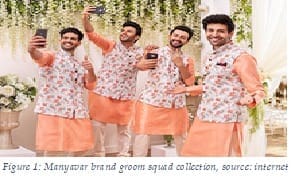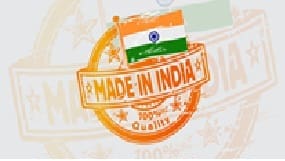“Everything is in a Name…Brand is all that we hear & wear!!!”
People are always behind making their status in the society, the brands of goods hold a great value in the minds of people. Globally, Polo, Ralf Lauren, Diesel, Calvin Klein, Gucci, Nike, Hugo Boss, Dolce and Gabbana & Armani etc. are the top men’s clothing brands whereas for women Gucci, Hermes, Prada, Chanel, Ralf Lauren, Burberry, House of Versace, Fendi, etc. are popular brands.
All said & done these are status symbols and each individual has it’s choice & liking, similarly, the brands have their own unique features and positioning in the market. However, during recent COVID-19 pandemic we realized that all our needs were fulfilled by our own Indian players and brands and a great level of responsible citizenship of our mother India was observed. Especially in case of medical textiles such as PPE kits, masks, etc. were produced by our textile players only under social obligation towards our Indian citizens. From almost nothing we became number 2 in the world for production of medical textiles.
 I think post COVID-19 era would be more for local. We have seen during pandemic, most of the countries sealed their borders to take care of their own citizens. This has emerged as a great responsibility towards our own country. From fashion point of view, international brands from USA, Europe etc. upscale the wardrobes and add value to their status. It’s this very psychology that has driven many Indian textile business houses to have westernized labels. These are the marketing trends. Most of these brands like Raymond, Peter England, American Swan, Allen Solly, Hidesign, Louis Philippe, Flying Machine, Spykar, etc. have aced their branding. The recent era has however seen branding of Indian traditions with brands like “Manyavar” focusing on the ethnic collections & localizing its use on festivities as well as on a casual Sundays.
I think post COVID-19 era would be more for local. We have seen during pandemic, most of the countries sealed their borders to take care of their own citizens. This has emerged as a great responsibility towards our own country. From fashion point of view, international brands from USA, Europe etc. upscale the wardrobes and add value to their status. It’s this very psychology that has driven many Indian textile business houses to have westernized labels. These are the marketing trends. Most of these brands like Raymond, Peter England, American Swan, Allen Solly, Hidesign, Louis Philippe, Flying Machine, Spykar, etc. have aced their branding. The recent era has however seen branding of Indian traditions with brands like “Manyavar” focusing on the ethnic collections & localizing its use on festivities as well as on a casual Sundays.

Figure 2.Made in India, source-internet
In recent years however the game is changing. The country has strategized to make its hard work be rewarded. The short falling of branding labels is being recognized & the master canvas of the “Make in India” label was introduced by the government. Personally, I considered it as the first stroke on the master canvas. The lack of overall individual labels was uplifted to be our strength by branding it as made in India. Giving brand recognition to our unlabeled products. The Quality, reputation & loyalty all key factors of marketing are associated with this “Brand” creations. The global market saw a new face of India to be a superpower well equipped as a manufacturing hub. The campaign of Make in India saw multiple international investments in the country & the brand creation of India began.
Vocal for Local is yet another brilliant masterstroke to India’s branding strategy. The pandemic situation & the shortcomings of businesses have created one fine stroke in this canvas of branding. Simple 2 words which on observations seem to be far away from branding our local businesses. Being the voice means presenting a trust factor, recognition & loyalty for quality products from a local source. All these efforts are made so that the local reaches the International markets. All these efforts are all targeted so that the brand creation is established by the Indian players. Using the wave of Internet sensation to create the brand strategy of all the manufacturers. This strategy plays with our strength the population by utilizing it to create the promotion for all the deserving product basket of our country. It is not just a movement to make India ‘Aatma Nirbhar’ self-reliant, it comes with a complete package outlaying several measures for MSMEs considering the priority to local brands.
The tweet #vocalforlocal led to a wave of changes across the country opting for local resources. People are now looking out for manufacturing details on every product they purchase from the FMCG industry to the electronics industry.
Welspun & Trident are the top home textiles brands of the country. Both are prominent terry towel producers of the world and have expanded their product portfolio.

Figure 3: Aditya Birla Liva Brand, source: website
Aditya Birla Group’s Birla Cellulose is a World leader in Viscose Staple Fibre (VSF) and has a commendable position with major world market share. They have done a strategic forward integration with their “Liva brand” which is the success story showcasing how a non-direct customer commodity branding is also critically essential. Customers now look for Liva on their end product making the name of a fiber engrossed in the customer’s mind through the fabric.
All these companies have encored the importance of branding and are today reaping the profits of their branding efforts. It is now time to encash on the opportunities created by the government and make a label that gets engrossed for years to come.
The current situation after the COVID-19 setback, is showing some promising results. It is considered to start a Boom Time for Textile Industry as global apparel firms shift orders to India from China. German leisure wears brand Marc O’Polo has placed a huge order for Jerseys to its Indian vendor Warsaw International. The product was earlier being supplied by the German garment firm’s Chinese vendor. The United States-based Carter, once the largest babywear brand in the world, also wants to shift its significant portion of its business from China to India. It has asked Tamil Nadu based SP Apparels to work on developing a new fabric using man-made fibers. Many such positive indications are expected in Post COVID-19 era.
Summary:
Apart from creating a branding strategy for India “Vocal for local”, “Atmanirbhar India- self-reliant”. The importance of the development of functional textiles & its forecasted demand for our own country’s developing needs in terms of infrastructure, health & infrastructure planning along with the global demand for these high-end products. Under Union Budget 2020-21, a National Technical Textiles Mission is proposed for a period from 2020-21 to 2023-24 at an estimated outlay of Rs 1,480 crore (US$ 211.76 million). This is our time to grab the market & develop the branding of Make in India.
For Textiles & Apparels business many new initiatives are created to make local go global by India. The Directorate General of Foreign Trade (DGFT) has revised rates for incentives under the Merchandise Exports from India Scheme (MEIS) for two subsectors of the Textiles Industry – readymade garments and made-ups – from two percent to four percent. The Government of India has taken several measures including Amended Technology Up-gradation Fund Scheme (A-TUFS), estimated to create employment for 35 lakh people and enable investment worth Rs 95,000 crore (US$ 14.17 billion) by 2022.
It is now time to create a brand that is voiced by people with the measures of delivering a product that remains consistent on its quality parameters. Nowadays, the digital world can make a Brand grow & blossom from local to international. The time has come to adopt innovative marketing techniques in the global as well as domestic markets. Understanding strength of our “local” market for which we need to be “vocal” and time is not that far when most of the global brands will queue up themselves to come to India and that’s the master stroke of “Vocal for Local” so that those who would like to cater to Indian customers have to come to “Atmanirbhar India.”
India is all set to stage a platform through innovative marketing skills of encashing on our huge population and asking them to be “Atmanirbhar” and demanding “Vocal for Local.” Let us take a thread from here and shine on the international market during POST COVID-19 taking some small share from our dear friend China!!!

By Mr. Avinash Mayekar, MD & CEO,
Suvin Advisors Pvt. Ltd.

